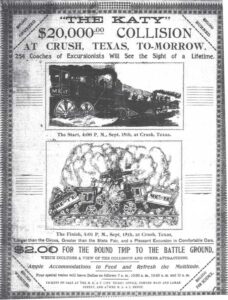
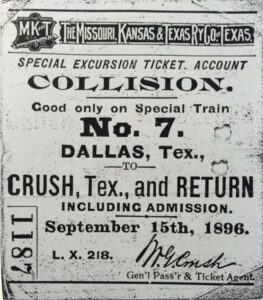 Some of the most horrific kinds of accidents that happen on the railroad are head-on collisions. In these types of accidents, it is almost always the fault of a person, commonly known as “human error.” Once in a while, the signal lights could be defective too, but that is less common than when the person responsible for watching the signal lights is “asleep” at their post, either literally or figuratively. However, on September 15, 1896, neither of these scenarios was the case. Nor was the ensuing crash a terrorist attack. It was actually a planned event. What would make a railway company purposely run two locomotives into each other, head-on? Your guess is as good as mine.
Some of the most horrific kinds of accidents that happen on the railroad are head-on collisions. In these types of accidents, it is almost always the fault of a person, commonly known as “human error.” Once in a while, the signal lights could be defective too, but that is less common than when the person responsible for watching the signal lights is “asleep” at their post, either literally or figuratively. However, on September 15, 1896, neither of these scenarios was the case. Nor was the ensuing crash a terrorist attack. It was actually a planned event. What would make a railway company purposely run two locomotives into each other, head-on? Your guess is as good as mine.
It was actually a publicity stunt. The area north of Waco, was a shallow valley near the tracks of the Missouri, Kansas, and Texas Railroad, also known as the Katy. There was no town there, so a “pop up” town, named Crush, Texas, was formed and was named after William George Crush, who was a passenger agent for the Katy. In 1895, Crush had the crazy idea of staging a train wreck as a way to generate passenger ticket sales. I’m not sure if I would want to buy a ticket for the train, if I had seen the possibility of a head-on collision come to life before my eyes, but apparently some people would. At that time, Texas, like much of the rest of the country, was in a serious economic depression, so Crush convinced the Katy company officials that his scheme would be a creative marketing ploy and attraction. I suppose we all tend to like to watch the spectacular, and a crash of that magnitude…knowing that now one would be hurt…would be interesting.
That summer, the Katy bombarded Texans with advertising for the “Monster Crash.” If they were going to purposely destroy two locomotives and the attached railcars, they wanted plenty of spectators. They put daily preparation reports in many newspapers, and the publicity even stretched beyond the state border. The two locomotives were chosen. They would use Old Number 999, which they painted green, and Number 1001, which they painted red. For a time, they two locomotives toured around to generate interest.
Thousands of Texans came out to see the locomotives during their tour, and then in early September several hundred Katy workmen began staging the town. Obviously not wanting to shut down the main line tracks for the cleanup that would have to follow the crash, they laid four miles of track off of the Waco-Dallas line that would be at a slight downward grade for both engines to the point of impact. A grandstand was constructed, along with three speaker’s stands, a bandstand, telegraph office, and a circus tent to act as a restaurant. The atmosphere was set with a huge carnival midway that featured game booths, drink stands, and medicine 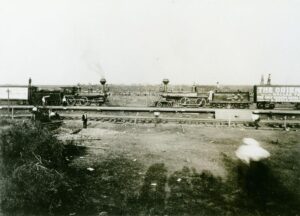 shows. And to put the final touch, they erected a special depot with a 2,100-foot platform and a sign welcoming passengers to Crush, Texas. I suppose it was similar to staging a movie these days.
shows. And to put the final touch, they erected a special depot with a 2,100-foot platform and a sign welcoming passengers to Crush, Texas. I suppose it was similar to staging a movie these days.
It was a known fact that in most collisions of this type, the engines would force each other up into a V and the rest of the cars would accordion behind them, making a boiler explosion less likely. Still, they didn’t want to take any chances, so they set up a safety perimeter of 150 yards around the pre-determined collision point and no one would be allowed in the danger zone. Crush told reporters, “The place selected for the collision is a natural amphitheater, and nobody will have any trouble viewing the entire exhibition.”
Tickets to the event were priced at $2.00, and they expected about 20,000 prople from around the state. What they got, was 40,000 people, and some passengers had too ride on top of railcars to get to the site. On that one day, the town of Crush, Texas became the second largest city in Texas. The event was scheduled for 4pm, but since people were still coming into town, they delayed the collision by one hour. Finally, at 5pm, the two locomotives, each pulling six cars moved into position at opposite ends of the four-mile track. Finally, the spectacle was ready. Crush rode a white horse to the middle of the track, raised his white hat, then after a dramatic pause, whipped it down as the signal for the engines to start. The crowd pressed forward for a better view, and the locomotive crews jumped to safety leaving the massive 35-ton iron monsters on their 50 mile per hour course to disaster. For dramatic effect, the Katy employees had placed small charges along the rail line to create warning blasts as the locomotives passed them.
Unfortunately, Crush and Katy rail officials had underestimated just how powerful the collision would be. The trains hit with between 1 and 2 million pounds of force, and despite what the engineers thought would happen, the boilers on both exploded. The sound of the collision was deafening, and the collision filled the air with flying metal. The panicked crowds tried to run to safety. The debris, ranging from the size of a postage stamp to half a driving wheel, rained down of the crowd for about 300 yards. Sadly, not everyone would make it out alive. At least two people were killed, and several injured. Shockingly, some of the injuries occurred after the crash when spectators rushed to collect souvenirs, not realizing it would burn their hands. Waco based photographer Jervice Deane, lost his right eye to a flying bolt that lodged in his skull. Amazingly, he survived the injury.
The planned disaster was quickly cleaned up by railroad crews and souvenir hunters, and by nightfall, the town of Crush ceased to exist. For his part in all this, Katy rail officials fired George Crush that night, because they 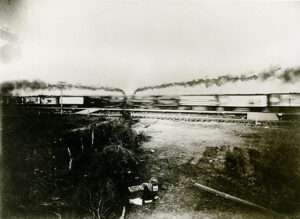
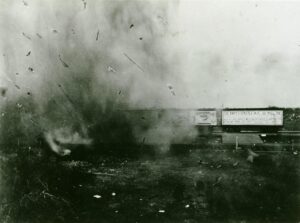 were anticipating a large backlash and lawsuits resulting from the larger than expected explosion. Nevertheless, the publicity stunt worked, train ticket sales increased. In a “back by popular demand” kind of move, Crush was re-hired within days. His days as a showman, however, were over. The railroad quietly settled the resulting lawsuits with cash and lifetime rail passes. Crush stayed on with the railroad until his retirement in 1940.
were anticipating a large backlash and lawsuits resulting from the larger than expected explosion. Nevertheless, the publicity stunt worked, train ticket sales increased. In a “back by popular demand” kind of move, Crush was re-hired within days. His days as a showman, however, were over. The railroad quietly settled the resulting lawsuits with cash and lifetime rail passes. Crush stayed on with the railroad until his retirement in 1940.


Leave a Reply